The Gold RushA Golden opportunityMaritime Gold Rush Education Program Puts Students in the Prospector's Seat Picture yourself risking your life as you board a ship and travel around treacherous Cape Horn on a four-month journey in an overcrowded vessel filled with sickness and hunger. You arrive in the bustling, chaotic port of San Francisco, weary but excited that your dreams will soon be fulfilled and you will return home a happy and prosperous person. Now imagine that you are eleven years old. Fourth, fifth and sixth grade students around Northern California embark on exactly this imaginary voyage in preparation for the Maritime Park Association's Gold Rush field trip on Hyde Street Pier. Once they arrive on the pier the students are immersed in an environmental living program which expands on their advance research and invites them to explore the rugged era of the Gold Rush from a maritime perspective. Before the gold-seekers can gather their wits, the local shipping agent
greets them and informs the wide-eyed newcomers that opportunities abound
not only in the hills, but also in San Francisco's ports and shops. As
a shipping agent, he says he is well connected along the waterfront and
knows a captain, a merchant and a miner who are all looking for help in
their respective businesses. "It is easier to 'mine the miner' than the
mines," he insists. The students are invited to meet each character, explore
their vocations first hand and then choose their own destinies.
During this day of hands-on experience, the young prospectors come to
understand that the California Gold Rush was a bit more complex than they
expected and that their fortunes may not be made in the hills - and in
fact, may not be made at all. They also learn to appreciate the far reaching
effects the Gold Rush had on Bay Area history. 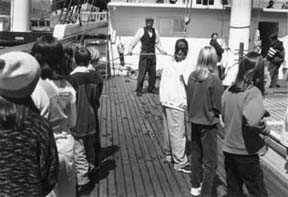
At the end of the day, their destinies lie in their own hands as each student chooses which path to follow. Whether to a life at sea, a career in sales, or a risky adventure into uncharted Gold Country, each path leads the now experienced student to a deeper appreciation of maritime history.
For more information or to make reservations, please contact Education Coordinator, Alice Watts via email, or call (415) 561-6662 x 1004
|

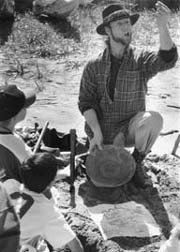 Imagine
yourself as an adventuresome man in 1849, leaving your wife, children,
home and the relative stability of the Eastern seaboard behind, withdrawing
your life savings and packing enough supplies to survive in the hope that
you will strike gold in the hills of California.
Imagine
yourself as an adventuresome man in 1849, leaving your wife, children,
home and the relative stability of the Eastern seaboard behind, withdrawing
your life savings and packing enough supplies to survive in the hope that
you will strike gold in the hills of California.
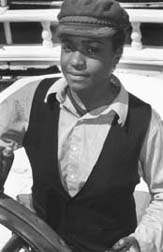 The
captain of the Balclutha is getting quite rich transporting men and
lumber up and down the coast; unfortunately he cannot keep good sailors
aboard his vessel. He shows the students his impressive ship and extols
the virtues of life at sea. "Anything," he says, "is better than having
your feet stuck in clay!" However, the captain wants an experienced, able-bodied
crew and tests the students' abilities by having them perform basic tasks
like raising a sail and testing the depth of the water.
The
captain of the Balclutha is getting quite rich transporting men and
lumber up and down the coast; unfortunately he cannot keep good sailors
aboard his vessel. He shows the students his impressive ship and extols
the virtues of life at sea. "Anything," he says, "is better than having
your feet stuck in clay!" However, the captain wants an experienced, able-bodied
crew and tests the students' abilities by having them perform basic tasks
like raising a sail and testing the depth of the water. 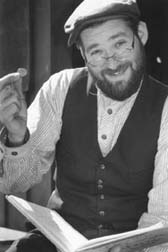 The
merchant has perfected the art of selling mining supplies for exorbitant
prices. Although he has never left the waterfront, he is benefiting more
than most "forty-niners" from the rush of gold-seekers. The merchant needs
Stevedores (cargo handlers) to unload cargo from ships and help out in
his warehouses. The students must prove that they are both capable and
dependable because unloading cargo is a tricky, precise task that takes
team work. In turn, the merchant promises "security, wealth and the comfort
of a warm home and a sound meal."
The
merchant has perfected the art of selling mining supplies for exorbitant
prices. Although he has never left the waterfront, he is benefiting more
than most "forty-niners" from the rush of gold-seekers. The merchant needs
Stevedores (cargo handlers) to unload cargo from ships and help out in
his warehouses. The students must prove that they are both capable and
dependable because unloading cargo is a tricky, precise task that takes
team work. In turn, the merchant promises "security, wealth and the comfort
of a warm home and a sound meal." 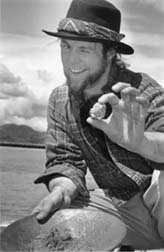 Finally, the miner appeals to the students' sense of adventure as
he boasts of untold fortunes lying undiscovered in the hills. He shows
the young people the tools of his trade, instructs them on the geology
of gold mining and even shares with them a map which he believes will lead
them to their fortunes. The miner also needs assistance but will only take
hardy, brave souls who can demonstrate a simple knowledge of gold mining.
Finally, the miner appeals to the students' sense of adventure as
he boasts of untold fortunes lying undiscovered in the hills. He shows
the young people the tools of his trade, instructs them on the geology
of gold mining and even shares with them a map which he believes will lead
them to their fortunes. The miner also needs assistance but will only take
hardy, brave souls who can demonstrate a simple knowledge of gold mining.
